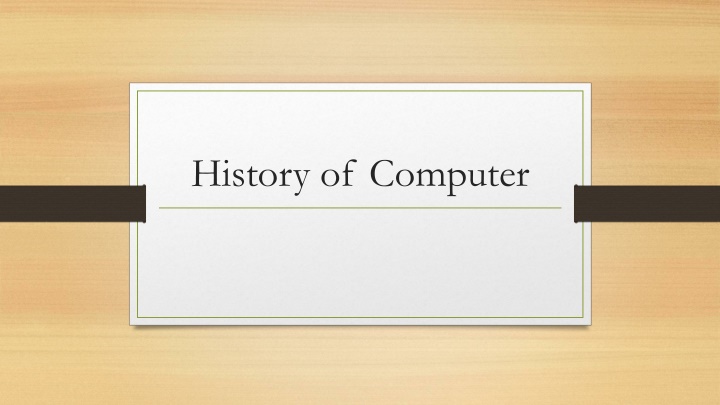
Evolution of Computers Through the Ages
Explore the fascinating history of computers from the earliest human calculators to the advanced generations of today. Learn about the defining characteristics of computers, their evolution through generations, and the technological advancements that shaped their development.
Download Presentation

Please find below an Image/Link to download the presentation.
The content on the website is provided AS IS for your information and personal use only. It may not be sold, licensed, or shared on other websites without obtaining consent from the author. If you encounter any issues during the download, it is possible that the publisher has removed the file from their server.
You are allowed to download the files provided on this website for personal or commercial use, subject to the condition that they are used lawfully. All files are the property of their respective owners.
The content on the website is provided AS IS for your information and personal use only. It may not be sold, licensed, or shared on other websites without obtaining consent from the author.
E N D
Presentation Transcript
Topics 1. Definition of computer 2. Earliest computer 3. Computer History 4. Computer Generations
Definition of Computer Computer is a programmable machine. Computer is a machine that manipulates data according to a list of instructions. Computer is any device which aids humans in performing various kinds of computations or calculations.
Three principles characteristic of computer: It responds to a specific set of instructions in a well defined manner. It can execute a pre-recorded list of instructions. It can quickly store and retrieve large amounts of data.
Earliest Computer Originally calculations were computed by humans, whose job title was computers. These human computers were typically engaged in the calculation of a mathematical expression. The calculations of this period were specialized and expensive, requiring years of training in mathematics. The first use of the word "computer" was recorded in 1613, referring to a person who carried out calculations, or computations, and the word continued to be used in that sense until the middle of the 20th century.
Computer Generations There are five generations of computer: First generation 1946 - 1958 Second generation 1959 - 1964 Third generation 1965 - 1970 Fourth generation 1971 - today Fifth generation Today to future
The First Generation The first computers used vacuum tubes for circuitry and magnetic drums for memory, and were often enormous, taking up entire rooms. They were very expensive to operate and in addition to using a great deal of electricity, generated a lot of heat, which was often the cause of malfunctions. First generation computers relied on machine language, the lowest-level programming language understood by computers, to perform operations, and they could only solve one problem at a time. Input was based on punched cards and paper tape, and output was displayed on printouts.
The Second Generation Transistors replaced vacuum tubes and ushered in the second generation of computers. One transistor replaced the equivalent of 40 vacuum tubes. Allowing computers to become smaller, faster, cheaper, more energy-efficient and more reliable. Still generated a great deal of heat that can damage the computer. Second-generation computers moved from cryptic binary machine language to symbolic, or assembly, languages, which allowed programmers to specify instructions in words. Second-generation computers still relied on punched cards for input and printouts for output. These were also the first computers that stored their instructions in their memory, which moved from a magnetic drum to magnetic core technology
The Third Generation The development of the integrated circuit was the hallmark of the third generation of computers. Transistors were miniaturized and placed on silicon chips, called semiconductors, which drastically increased the speed and efficiency of computers. Much smaller and cheaper compare to the second generation computers. It could carry out instructions in billionths of a second. Users interacted with third generation computers through keyboards and monitors and interfaced with an operating system, which allowed the device to run many different applications at one time with a central program that monitored the memory. Computers for the first time became accessible to a mass audience because they were smaller and cheaper than their predecessors
The Fourth Generation The microprocessor brought the fourth generation of computers, as thousands of integrated circuits were built onto a single silicon chip. As these small computers became more powerful, they could be linked together to form networks, which eventually led to the development of the Internet. Fourth generation computers also saw the development of GUIs, the mouse and handheld devices
The Fifth Generation Based on Artificial Intelligence (AI). Still in development. The use of parallel processing and superconductors is helping to make artificial intelligence a reality. The goal is to develop devices that respond to natural language input and are capable of learning and self-organization. There are some applications, such as voice recognition, that are being used today.
